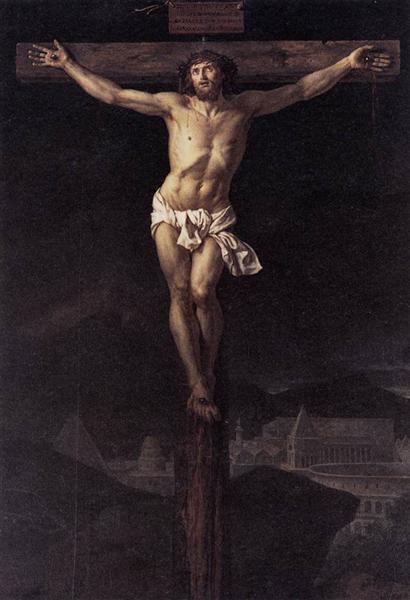Beschrijving
Het werk "Christus On the Cross" door Jacques-Louis David, geschilderd in 1782, vertegenwoordigt een moment van diepe contemplatie en technische uitvoering van de meester die het drama en het centrale offer oproepen in het christelijke verhaal. In dit schilderij bereikt David, bekend om zijn link naar neoklassicisme en zijn vermogen om geschiedenis samen te voegen met emotie, een krachtige synthese van vorm en inhoud, waardoor de figuur van Christus wordt verhoogd tot een weergave die de louter religieus overstijgt en een meer verbinding op zoek is de toeschouwer.
In het midden van de compositie is Christus de absolute focus; Zijn lichaam wordt gepresenteerd met een duidelijke en realistische anatomie die de invloed van klassieke sculptuur weerspiegelt, een traditie die David zorgvuldig hecht. De positie van Christus, met zijn romp hellende naar de zijkant en de armen, vangt zowel de pijn van het offer als een ongewone sereniteit, die suggereert dat een toestand van vrede te midden van het lijden. Zijn hoofd is geneigd naar beneden, wat een dimensie van verdriet en ontslag toevoegt aan zijn figuur, terwijl de uitdrukking van zijn gezicht, hoewel Serena een manifestatie vindt van de last die hij heeft aangenomen.
Het gebruik van kleur in "Christus on the Cross" is even opmerkelijk. David gebruikt een nuchter palet, waarin donkere tonen overheersen, die contrasteren met de lichten die de figuur van Christus benadrukken. Deze bijna theatrale verlichting benadrukt niet alleen het vennootschap van de hoofdrolspeler, maar vestigt ook een omgeving die reflectie en eerbied oproept. De bruine en grijsachtige tonen van de achtergrond combineren met de duidelijkste reflexen die het lichaam verlichten, waardoor een drie -dimensionaal effect ontstaat dat de blik van de kijker naar de gekruisigde aantrekt.
Bovendien mist schilderen extra karakters, die de eenzaamheid van Christus intensiveert in zijn lijden. Deze beslissing, typisch voor neoklassicisme, benadrukt de centraliteit van het individu en zijn strijd, een weerspiegeling van Davids ideologische overtuigingen, die zich in een tijd van politieke en sociale agitatie in Frankrijk bevond. De afwezigheid van verhalende elementen zoals het tumult van volgers of vijanden geeft een gevoel van isolatie dat resoneert met de boodschap van opoffering.
Het werk maakt deel uit van een artistieke traditie die, hoewel niet zo alomtegenwoordig in de tijd van David, echo's vindt in eerdere werken van leraren zoals Caravaggio of de barokke periode, waar drama en naturalisme in het centrum van het verhaal stonden. David onderscheidt zich echter van de uitbundigheid van de Barocco om een eenvoud en duidelijkheid van vormen te omarmen die morele en emotionele contemplatie uitnodigen, iets dat ook kan worden waargenomen in zijn bekendste werk, "de eed van de Horacios".
Het is interessant om te overwegen dat "Christus On the Cross" geen commissiewerk was, maar dat David het alleen maakte, op een moment dat zijn innovatieve geest hem aanmoedigde om nieuwe dimensies van religieuze kunst te verkennen. Zijn aandringen op het vertegenwoordigen van kwesties van opoffering en heldendom is nauw verbonden met de turbulente tijden die voorafgingen aan de Franse revolutie, momenten die David leefde en die zijn esthetiek en visie van de wereld meldden.
Concluderend, "Christus on the Cross" door Jacques-Louis David, houdt niet alleen een weergave van een heilig thema, maar stijgt naar een meditatie over eenzaamheid, opoffering en de mensheid in zijn puurste vorm. Door de meesterschap van David wordt de kijker uitgenodigd om na te denken over de betekenis van lijden en verlossing, een tijdloos thema dat vandaag blijft resoneren. Het werk is niet alleen een getuigenis van het technische vermogen van de kunstenaar, maar ook van het vermogen om menselijke dilemma's samen te voegen met een traditie die rijk is aan symboliek en emotie, kenmerken die hedendaagse kunst blijven inspireren en uitdagen.
KUADROS ©, een beroemde verf op je muur.
Handgemaakte olieverfschilderijen, met de kwaliteit van professionele kunstenaars en de onderscheidende afdichting van KUADROS ©.
Foto's Reproductieservice met tevredenheidsgarantie. Als u niet helemaal tevreden bent met de replica van uw schilderij, betalen wij uw geld 100%terug.

